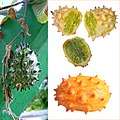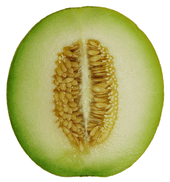Cucumis metuliferus
Cucumis metuliferus, commonly called the horned melon, spiked melon, jelly melon, or kiwano, is an annual vine in the cucumber and melon family, Cucurbitaceae. Its fruit has horn-like spines, hence the name "horned melon". Ripe fruit has orange skin and lime green, jelly-like flesh with a refreshingly fruity taste, and texture similar to a passionfruit or pomegranate.[1] C. metuliferus is native to Sub-Saharan Africa.[2][3] It is now grown in the United States, Portugal, Italy, Germany, Chile, Australia, and New Zealand.
| Horned melon | |
|---|---|
| Cucumis metuliferus fruit | |
| Scientific classification | |
| Kingdom: | Plantae |
| Clade: | Tracheophytes |
| Clade: | Angiosperms |
| Clade: | Eudicots |
| Clade: | Rosids |
| Order: | Cucurbitales |
| Family: | Cucurbitaceae |
| Genus: | Cucumis |
| Species: | C. metuliferus |
| Binomial name | |
| Cucumis metuliferus E. Mey | |
| Nutritional value per 100 g (3.5 oz) | |
|---|---|
| Energy | 183 kJ (44 kcal) |
7.56 g | |
1.26 g | |
1.78 g | |
| Vitamins | Quantity %DV† |
| Vitamin A equiv. | 1% 7 μg1% 88 μg |
| Thiamine (B1) | 2% 0.025 mg |
| Riboflavin (B2) | 1% 0.015 mg |
| Niacin (B3) | 4% 0.565 mg |
| Pantothenic acid (B5) | 4% 0.183 mg |
| Vitamin B6 | 5% 0.063 mg |
| Folate (B9) | 1% 3 μg |
| Vitamin C | 6% 5.3 mg |
| Minerals | Quantity %DV† |
| Calcium | 1% 13 mg |
| Copper | 1% 0.020 mg |
| Iron | 9% 1.13 mg |
| Magnesium | 11% 40 mg |
| Manganese | 2% 0.039 mg |
| Phosphorus | 5% 37 mg |
| Potassium | 3% 123 mg |
| Sodium | 0% 2 mg |
| Zinc | 5% 0.48 mg |
| Other constituents | Quantity |
| Water | 88.97 g |
| |
| †Percentages are roughly approximated using US recommendations for adults. Source: USDA Nutrient Database | |
Kiwano is a traditional food plant in Africa. Along with the Gemsbok cucumber (Acanthosicyos naudinianus) and Tsamma (Citron melon) it is one of the few sources of water during the dry season in the Kalahari Desert.[4][5] In northern Zimbabwe it is called gaka or gakachika,[6] and is primarily used as a snack or salad, and rarely for decoration. It can be eaten at any stage of ripening, but when overripened, will burst forcefully to release seeds.
The fruit's taste has been compared to a combination of banana and passionfruit[3] or a combination of banana, cucumber and lime.[7] Upon tasting it for the first time on-air in 1987, David Letterman described it as "damned near inedible."[8] A small amount of salt or sugar can increase the flavor but the seed content can make eating the fruit less convenient than many common fruits.
Some also eat the peel, which is very rich in vitamin C and dietary fiber.[9]
Germination
Seeding optimum germination temperatures are between 20° and 35 °C (68° to 95 °F). Germination is delayed at 12 °C (54 °F), and inhibited at temperatures lower than 12 °C or above 35 °C. Thus, it is recommended to sow in trays and transplant into the field at the two true leaf stage. The best time for transplanting into an open field is in the spring when soil and air temperatures rise to around 15 °C (59 °F).
Pests and diseases
It was found that kiwano is resistant to several root-knot nematodes, two accessions were found to be highly resistant to Watermelon mosaic virus (WMV-1), but very sensitive to the Squash mosaic virus (SqMV). Some accessions were found to succumb to Fusarium wilt. Resistance to Greenhouse whitefly was reported. Kiwano was reported to be resistant to Powdery mildew, however in Israel powdery mildew as well as the Squash mosaic virus (SqMV) attacked kiwano fields and measures had to be taken.[10]
Gallery
References
- "Kiwano information - Exotic fruits | Its almost like a sour berry. Nature's Pride". www.naturespride.eu. Retrieved 2015-06-07.
- Welman, Mienkie. "Cucumis metuliferus". PlantZAfrica.com. South African National Biodiversity Institute. Retrieved 7 June 2015.
- "Living - Kiwano: It's what's inside that counts - Seattle Times Newspaper". nwsource.com.
- (in French) Parc de Khal-agadi, pas si désert, in Science & Vie n° 1130, November 2011, pp. 18-21.
- Ben-Erik Van Wyk (2000). People's Plants: A guide to useful plants of southern Africa. South Africa: Briza Publications. p. 38. ISBN 978-1-875093-19-9. Archived from the original on 2015-06-26. Retrieved 2015-01-10.
- Lim, T. K. (2012-01-30). Edible Medicinal And Non-Medicinal Plants: Volume 2, Fruits. Springer Science & Business Media. ISBN 9789400717633.
- "The Dinner Diva: Let's discover some more little-known fruits". DeseretNews.com. 21 February 2008.
- "Remembering 'Kiwi Queen' Frieda Caplan, Who Expanded U.S. Supermarket Offerings". All Things Considered. NPR. January 27, 2020. Retrieved 28 January 2020.
- "Mountain Herb Estate - VEGETABLE - CUCUMBER, AFRICAN HORNED, Jelly Melon, Kiwano, Rooi-agurkie, Rooikomkommer (Afr.), Mokapana (Tswana) (Cucumis metuliferus)". www.herbgarden.co.za. Retrieved 2015-06-07.
- Benzioni, Aliza. "Kiwano". www.hort.purdue.edu. Purdue University. Retrieved 3 June 2015.





